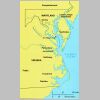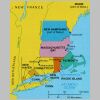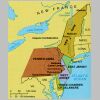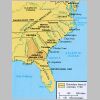The history of the original 13 colonies is a tangled tale
indeed. There are many ways to view the events and, in hind
sight, it is easy to think you understand. But no one knew where
they were headed at the time and it could have ended up very
different.
A Map of the Colonies At the End of the Revolution
A new Colonial Time Line
Hargrett Rare Library Map Collection - Colonial America
Boundaries of the Contiguous United States - Animation
Other maps from the Colonial Period (1,
2,
3,
4,
5,
6,
7,
8)
Colonial Charters, Grants and Related Documents
[ Massachusetts | Rhode Island | Connecticut | New Hampshire ]
[ New York | Delaware | New Jersey | Pennsylvania ]
[ Virginia | Maryland | North Carolina | South Carolina | Georgia ]
Charter to Sir Walter Raleigh : 1584
Everybody remembers Jamestown, Capt. John Smith,
Pocahontas and all the rest. But do you remember Roanoke? In
1585, after a small scouting expedition had returned from North America
with two Native Americans and many astonishing stories, Sir Walter Raleigh
tried to establish a colony called
Roanoke in the land which the British named "Virginia", in honor of
Elizabeth, the Virgin Queen. The site was actually an island on
North America's eastern seaboard protected by the outer
banks of what is now North Carolina's coast. Sir Richard Grenville led the
fleet that brought them to the New World, the Governor of
the colony was Master Ralph Lane and among the colonists
was Walter Raleigh's confidant Thomas Harriot, author of
"A Briefe and True Report of the New Found Land of Virginia", a
chronicle of their adventure. Sir Francis Drake,
who was seeking Spanish conquests in the New World,
rescued this group just as they were losing control of their situation. Another colony was left at Roanoke in
1587 but by 1590, when a long delayed supply ship finally arrived, they had disappeared without a trace. This was the
so-called "Lost Colony". A baby was born in Roanoke at this time.
Little
Virginia Dare,
was the granddaughter of John White, the appointed Governor of the "Lost Colony",
and was probably the first English baby born in the New World. Sir Walter Raleigh sent
ships to America to search for the colonists but they were unsuccessful. By the time the next English settlers
arrived in North America to colonize Jamestown it was nearly twenty years later and,
although several attempts were made to find out what happened to them, the fate of the "Lost Colony" was never fully explained.
(1607)
Virginia
[Homepage
, Constitution]
(
Roots-L Database
, Instructions for the Virginia Colony (1606)
, The First Virginia Charter (April 10, 1606)
, Statehouse History
, Jamestown History
, Jamestown Rediscovery Project
, History of Jamestown
, First English Settlement
, The Real Pocahontas
, Historic Jamestown
, Jamestowne Society
, Colonial Williamsburg Home Page
, Virtual Jamestown
)
 Based on George Weymouth's accounts of voyages to the
New England area in 1606, two private companies were formed
to seek a patent for colonization on the Atlantic Coast. One
of these companies was called the London Company and it was
given the southern Virginia territory. The other company was
called the Plymouth Company and its patent was for northern
Virginia. Both companies quickly sought to exercise their
patents but the London Company was the first to actually
place colonists on the shore. In 1607, 105 London Company
sponsored settlers arrived from England to begin the
story that we all remember from our school days. Since they were there representing
England and its King, James I, they settled in an encampment they called Jamestown
on a river they named the James River.
Based on George Weymouth's accounts of voyages to the
New England area in 1606, two private companies were formed
to seek a patent for colonization on the Atlantic Coast. One
of these companies was called the London Company and it was
given the southern Virginia territory. The other company was
called the Plymouth Company and its patent was for northern
Virginia. Both companies quickly sought to exercise their
patents but the London Company was the first to actually
place colonists on the shore. In 1607, 105 London Company
sponsored settlers arrived from England to begin the
story that we all remember from our school days. Since they were there representing
England and its King, James I, they settled in an encampment they called Jamestown
on a river they named the James River.
The first year was devastating for the colonists, with
only 32 colonists surviving the winter and only then because Native Americans living in the area
came to their aid with food. After a supply ship arrived the next year they had additional
provisions but many more colonists to feed as well. Once again, over the winter, most of the colonists died of starvation
and from hostile encounters with their neighbors.
As winter came to a close, ships arrived, and most of them were ready to leave. But as they were leaving,
Lord Thomas de la Warr (Delaware is named after him) arrived from England with new supplies
and more settlers. He refused to let the survivors return to England.
Slowly, as they reached agreements with the local Native American tribes and they learned how to grow some
of their own crops, the colony began to prosper.
Most of those original Jamestown settlers were after profit, mainly riches in the form
of gold and other precious metals. They had not given enough thought to the
perils that they would face in this unknown land. One of the settlers, however,
was familiar with hardship and was committed to Jamestown's survival. Capt.
John Smith was a soldier and adventurer. He had fought in France and Hungary,
been captured and escaped. Although his personality caused him some initial
problems with the other colonists (he arrived in Jamestown in chains after
alienating the leaders of the expedition) he eventually made contact with the local
Native American chieftain Powhatan, who provided the colonists with much of
their food in that first year. Capt. Smith was eventually even appointed leader of the colony.
One of Powhatan's children, a daughter called Pocahontas, visited the
colonists in the early years and even brought food and other provisions to them. Several years later
in an attempt to obtain bargaining advantage over Powhatan the colonists kidnapped Pocahontas
and she stayed with them in Jamestown. A colonist, John Rolfe (who incidentally was the first of the colonists
to cultivate commercial quality tobacco and start the Colony on its way towards profitability)
eventually married her and took her to England. She died as they were preparing to return to
Virginia.
In 1619 a group of 20 African slaves arrived in Jamestown on a Dutch ship.
Grouped with the Southern Colonies, Virginia started out as a Corporate colony
(granted by Royal charter to a Company of investors who have governing rights)
but in 1624 became a Royal colony (subject to the governing authority of the granting Royalty).
In 1676 the village of Jamestown was nearly destroyed during
"Bacon's Rebellion."
In 1788 Virginia was the tenth state to ratify the Constitution and
recommended the Bill of Rights be added.
(1620) Massachusetts
[Homepage, Constitution]
(Roots-L Database
, The Plymouth Colony Archive Project
, The 1629 Charter Of Massachusetts Bay
, Commonwealth of Massachusetts - History
, What to See and Do at Plimoth Plantation
, Boston History
, Plimoth-on-Web.(Library)
, The Pilgrim Society
, Salem @ nationalgeographic.com
, The Pilgrims and Plymouth Colony:1620
)
In 1607, about the same time as the Jamestown colonization, a group of English
colonists attempted to establish a colony in the Northern Virginia territory. The colony, a fort named Fort St. George, was
located in present day Maine and was named Popham after its leader George Popham.
It lasted for approximately a year before the discouraged settlers returned to England.
 The Pilgrims were the first English colonists to permanently settle in New England in what we now know as Massachusetts. On Sept. 16,
1620 the ship "Mayflower" set off from Plymouth, England
on it journey to the New World. There were 102 passengers on the Mayflower
including 41 Christian Puritan Separatists known collectively as the Leiden group.
After spending many years in Holland exiled from the English Church, the Puritans
were seeking a new life of religious freedom in America. All 102 of the passengers
were referred to as the "Pilgrims" after they arrived. The group had obtained a
Patent from the London Virginia Company which indentured them into service for the
Company for seven years after they arrived and settled. To prepare for their life
in America, they had sought advice from people who had already visited the New World.
Among their advisors was Captain John Smith who, earlier, had helped found Jamestown for the
Virginia Company. It took sixty six days to reach New England and the journey was very
hard for these non-seafarers. When they arrived they anchored off the tip of
Cape Cod, in an area now known as Massachusetts, and before they even set foot on
shore they wrote, and all the men signed, an agreement called the "Mayflower Compact" that would
set the rules to guide them through the early, hard times of establishing a new
community. The Compact, which was signed on November 21, 1620 (modern date, see note below.), served as the
official Constitution of the Plymouth Colony for many years.
The Pilgrims were the first English colonists to permanently settle in New England in what we now know as Massachusetts. On Sept. 16,
1620 the ship "Mayflower" set off from Plymouth, England
on it journey to the New World. There were 102 passengers on the Mayflower
including 41 Christian Puritan Separatists known collectively as the Leiden group.
After spending many years in Holland exiled from the English Church, the Puritans
were seeking a new life of religious freedom in America. All 102 of the passengers
were referred to as the "Pilgrims" after they arrived. The group had obtained a
Patent from the London Virginia Company which indentured them into service for the
Company for seven years after they arrived and settled. To prepare for their life
in America, they had sought advice from people who had already visited the New World.
Among their advisors was Captain John Smith who, earlier, had helped found Jamestown for the
Virginia Company. It took sixty six days to reach New England and the journey was very
hard for these non-seafarers. When they arrived they anchored off the tip of
Cape Cod, in an area now known as Massachusetts, and before they even set foot on
shore they wrote, and all the men signed, an agreement called the "Mayflower Compact" that would
set the rules to guide them through the early, hard times of establishing a new
community. The Compact, which was signed on November 21, 1620 (modern date, see note below.), served as the
official Constitution of the Plymouth Colony for many years.
For nearly a month they explored, by foot
and in boats, the area around Cape Cod using the maps they had obtained in England.
During their exploration they had a few minor encounters with the local natives.
Finally, on December 21, they decided on a location near Plymouth Harbor which they
named Plymouth. Nearly half of the colonists and crew died from illnesses that
first winter as they struggled to build their town. The following spring they were
visited by a local Wampanoag native named Samoset who, surprisingly, spoke some
broken English. Eventually he introduced the settlers to another native named
Squanto who's village had occupied the area before the Pilgrims arrived. Squanto
had been kidnapped by English explorers and while he was in Europe the rest of his
people had all been killed by diseases brought by European explorers. Squanto spoke
English very well and he stayed with the Pilgrims and taught them many valuable
skills that enabled them to survive in their new country. He also played a very
big part in bringing the Pilgrims and the local native population together, leading,
eventually to a long, but restless, peace.
Not long after the Pilgrims arrived in Plymouth (1628) the Puritans
came to Massachusetts and settled Naumkeag (later called Salem). John Winthrop,
carrying the Massachusetts Bay Charter, arrived in 1630 and
founded Boston. Maine was annexed to Massachusetts in 1652
and later the Plymouth Colony was too.
The relationship between the Native tribes and the colonists in New England was
always strained but generally didn't result in much bloodshed. In 1637 colonists,with the cooperation of several
local tribes, mounted a devastating attack on a tribe known as the Pequots and then,
in 1675, the long accord that had existed between the New England colonists and the local native
tribes came apart in a bloody war known as King Phillip's War
after the leader of the Wampanoag tribe, Metacomet, who was also known by his English
nickname "King Phillip". Metacomet was the son of Massasoit the Wampanoag leader
who had originally greeted the Plymouth settlers.
Massachusetts was a New England colony which started out as a
Corporate colony but became a Royal colony in 1691
In 1788 Massachusetts was the sixth state to ratify the Constitution.
(1623) New Hampshire [Homepage, Constitution]
(Roots-L Database
, Grant of Hampshire to Capt. John Mason, 7th of Novemr., 1629
, A New Hampshire Almanac
, A Brief History of New Hampshire
)
In 1623 two groups of English settlers, sent by Captain John Mason, arrived in
what is now called New Hampshire (after John Masons home County of Hampshire) and established a fishing village near the
mouth of the Piscataqua River. New Hampshire would remain an English colony throughout the colonial period even though,
at various times, it came under Massachusetts jurisdiction. [Note from the webmaster: Thanks to an alert reader,
this is newly added information for New Hampshire (11/03/05).]
In 1638, John Wheelwright, banished from Boston for defending his sister-in-law Anne Hutchinson, founded a settlement called Exeter
in New Hampshire. In 1639 the settlers signed the "Exeter Compact" patterned after the "Mayflower Compact".
One of the New England Colonies, New Hampshire started out as a Proprietary colony but it
became a Royal colony in 1679.
In 1719 Scots-Irish settlers from Londonderry, Ireland were sent to form a "Scottish" settlement in New Hampshire
named for their town of origin.
In 1788 New Hampshire was the ninth state to ratify
the Constitution after which it was officially adopted.
(1623) New Jersey (originally New Netherlands)
[Homepage,
Constitution]
(Roots-L Database,
New Jersey colonial history,
Colonial New Jersey,
New Jersey History
)
[Note from the webmaster: This section has been updated to reflect New Jersey's early Dutch ties to New York. (11/12/05).]
Along with their holdings in New York, New Jersey was originally settled in 1623 by
the Dutch as New Netherlands
.
In 1664, after obtaining control of Dutch holdings lying between Virginia and New England,
the Duke of York made a proprietary grant
to Sir George Carteret and Lord Berkeley, of the land between the Hudson
and the Delaware River. These men intended to profit from real
estate sales. The new grant was named New Jersey for
Carteret, who was governor of the Isle of Jersey.
One of the Middle Colonies, New Jersey started out as a Proprietary colony but in 1702 it was granted a Royal charter
New Jersey, in 1787,
was the third state to ratify the Constitution.
(1624) New York (originally New
Amsterdam) [Homepage, Constitution]
(Roots-L Database,
Charter of the Dutch West India Company : 1621,
New York History Net,
New Netherland Project,
Colonial New York,
Historic New Amsterdam ,
Drums Along The Mohawk: The American Revolution on the New York Frontier) ,
Drums Along The Mohawk: The American Revolution on the New York Frontier)
 Although the Dutch West India Co. explored and began to
settle the New York area as early as 1614, the principal occupation of the area did not occur until 1624 when
Dutch settlers arrived at Governors Island and then spread to other areas in the region. In 1626,
as we all remember from our early history lessons, Peter Minuit
arrived on Manhattan Island and, with other Dutch settlers, bought the island from the local Indians for 60 gilders ($24.)
worth of goods. The settlement and fort on the island became known as New Amsterdam which eventually became the City of New York. The Dutch
holdings in the area were collectively called New Netherlands and included areas of what is now New Jersey.
New Amsterdam was granted self government and incorporated by the Dutch in
1653.
Although the Dutch West India Co. explored and began to
settle the New York area as early as 1614, the principal occupation of the area did not occur until 1624 when
Dutch settlers arrived at Governors Island and then spread to other areas in the region. In 1626,
as we all remember from our early history lessons, Peter Minuit
arrived on Manhattan Island and, with other Dutch settlers, bought the island from the local Indians for 60 gilders ($24.)
worth of goods. The settlement and fort on the island became known as New Amsterdam which eventually became the City of New York. The Dutch
holdings in the area were collectively called New Netherlands and included areas of what is now New Jersey.
New Amsterdam was granted self government and incorporated by the Dutch in
1653.
In 1664, after King Charles II decided to reclaim the territory between
Virginia and New England, Peter Stuyvesant surrendered to English forces
and New Amsterdam was given to the King's brother, the Duke of York, and renamed New York.
The Dutch continued to struggle with the British for control of New Netherlands off and on until 1674 when the
British finally obtained full control.
One of the Middle Colonies, New York originally
started out as a Proprietary colony (granted by Royalty
to one or more proprietors who had full governing rights) but in 1685 became a Royal colony
In 1788 New York became the
eleventh state to ratify the Constitution.
(1633) Maryland [Homepage, Constitution]
(Roots-L Database,
Maryland State Archives,
Maryland Timeline,
Maryland Historical Chronology)
In 1632 Charles I granted a Maryland Charter to Lord
Baltimore (George Calvert, Baron of Baltimore). Lord
Baltimore wanted very much to see the Colony become a reality
and his son Cecil saw to it that the new Colony was settled.
In 1633 the first group of settlers set sail for Maryland to
establish a colony of freemen led by Leonard Calvert, Cecil
Calvert's younger brother.
One of the Southern Colonies, Maryland was a Proprietary colony
Maryland was the seventh state to
ratify the Constitution in 1788.
(1636) Rhode Island [Homepage, Constitution]
(Roots-L Database,
Secretary of State - Know Rhode Island,
Rhode Island History)
While scattered Europeans began to settle the area as early as 1620, the first permanent
settlement wasn't established until 1636. In 1635 Roger Williams was driven from Salem, Massachusetts for espousing
religious and political freedom. After spending the winter
with the Indians he finally bought land from the Narragansett Indians and settled in what is now called
Providence. The new colony became a haven for those seeking
religious freedom.
In 1638, Anne Hutchinson, having been banned from Massachusetts, helped found Portsmouth, Rhode Island.
A New England Colony, Rhode Island was established as a Corporate colony and received a Royal "Charter of Rhode Island and Providence Plantations" in
1663. Among other unique guarantees, the Charter established complete religious freedom in Rhode Island, which was
unusual at the time, and later formed the basis for similar provisions in the U.S. Constitution.
Although Rhode Island was one of the first colonies to embrace autonomy
from the British and espouse Revolutionary ideals, it was the last of the 13
colonies to ratify the Federal Constitution and became a State in 1790.
(1636) Connecticut [Homepage, Constitution]
(Roots-L Database
, The Fundamental Orders of 1639
, Connecticut Colony Charter (1662)
, About Connecticut
, Connecticut History
, The Connecticut Historical Society
, Welcome to Connecticut History Online
)
Dutch traders had established a permanent settlement near Hartford as early as 1633.
Soon English settlers began to arrive in the area from Massachusetts.
In 1636, after being driven from Massachusetts, Clergyman Thomas Hooker and his followers arrived in
Hartford and declared freedom from all save Divine Authority.
In 1639 the "Fundamental Orders" were enacted to
govern the colony. In 1662 Connecticut finally obtained a
Royal Charter under John Winthrop Jr.
One of the New England Colonies, Connecticut was also a Corporate colony
In 1788 Connecticut was the
fifth state to ratify the Constitution.
(1638) Delaware (originally New
Sweden) [Homepage, Constitution]
(Roots-L Database,
Delaware - A Brief History,
Historical Maps,
This Day in Delaware History,
Delaware History Online - DelaWhen
)
In 1631, the first settlement was attempted in Delaware by
Dutch traders led by Captain David Pietersen de Vries. By
1632 the party had been killed in a dispute with the local natives.
In 1638, Peter Minuet, now in the service of the Swedish,
led a group of Swedish settlers to the Delaware River area
under a grant from the New Sweden Company. It was these Swedish settlers that brought the log cabin design to America.
In 1655 the Dutch gained
control of the land from the Swedish. In 1664 the
English obtained Delaware after defeating the Dutch. The Dutch briefly recaptured Delaware in 1673 but in 1674 the English finally took control. In 1682
Delaware was awarded to William Penn but his control didn't
last and Delaware became independent in 1701 and elected its own assembly in 1704.
One of the Middle Colonies, Delaware was a Proprietary colony
Delaware was
the first state to ratify the Constitution and become a State in 1787.
(1653) North Carolina [Homepage, Constitution]
(
Roots-L Database,
North Carolina History,
North Carolina Encyclopedia,
Welcome to the North Carolina Museum of History,
North Carolina Archaeology,
North Carolina's Historic Sites )
North Carolina's outer banks were the scene of the first British colonizing efforts in North America.
Both attempts, in the late 1500's, to form a colony on Roanoke Island (see above ) did not succeed.
 Virginia colonists began to settle the North Carolina
region in 1653 to provide a buffer for the southern frontier.
In 1691 Albermarle, the northern Carolina region, was
officially recognized by the English crown. This is the first
time the "North Carolina" designation was used.
Virginia colonists began to settle the North Carolina
region in 1653 to provide a buffer for the southern frontier.
In 1691 Albermarle, the northern Carolina region, was
officially recognized by the English crown. This is the first
time the "North Carolina" designation was used.
One of the Southern Colonies, North Carolina started out as a Proprietary colony but obtained a Royal charter in 1729 from George II.
After agreeing to the first 12 amendments, in 1789, North Carolina
became the 12th state to ratify the new Constitution.
(1663) South Carolina [Homepage, Constitution]
(Roots-L Database,
South Carolina- History,
A Brief History of South Carolina)
South Carolina was the site of the first European
settlement in North America. In 1526 San Miguel de Guadalupe was established
by settlers from Hispanolia who initially landed in South Carolina but ended up moving to an area of the Carolina region that would eventually become Georgia. The party returned to Hispanolia
after suffering many deaths due to fever the first year.
In 1663 King Charles II created the colony of Carolina
(named for King Charles II) by granting the territory, of what is now roughly North Carolina, South
Carolina and Georgia, to loyal supporters. This colonial charter
was challenged by many Virginians who had settled in Albermarle Sound
and resented their inclusion in the Carolina Charter. Charleston (originally
Charles Town after the King) was founded in 1670
by a group of 200 colonists from English Barbados. The leader of the colonists was Sir John Yeamans, a
powerful plantation owner on Barbados.
One of the Southern Colonies, South Carolina started out as a Proprietary colony but also became a Royal colony in 1719.
In 1788 South
Carolina was the eighth state to ratify the Constitution.
(1682) Pennsylvania
[Homepage,
Constitution]
(Roots-L Database,
Pennsylvania History,
Pennsylvania History,
THE QUAKER PROVINCE: 1681-1776,
Pennsylvania Historical and Museum Commission,
Mother Bedford,
William Penn's Charter,
Explore Pennsylvania History)
As early as 1647, settlement occured on what is now Pennsylvania soil
by Swedish, Dutch and English settlers in the Delaware River
region. In 1681 however, Pennsylvania's colonial status was sealed when approximately the present state of Pennsylvania
was granted to William Penn, a member of the Society of
Friends (Quakers), to offset a debt owed to Penn's father. In
1682 the city plan for Philadelphia was laid out. In 1682 the
"Frame of Government" for Pennsylvania was put into
effect. In 1683 the first German settlers arrived in
Pennsylvania and formed Germantown near Philadelphia.
One of the Middle Colonies, Pennsylvania was a Proprietary colony
In 1763, Charles Mason and Jeremiah Dixon, two young British astronomers
commissioned to establish a borderline between Maryland and Pennsylvania, worked for more
than four years to settle a century-old boundary dispute between the Calverts of
Maryland and the Penns of Pennsylvania by establishing the Mason-Dixon Line.
In 1787 Pennsylvania was the second state to ratify the Constitution.
(1732) Georgia
[Homepage, Constitution]
(Roots-L Database,
Georgia History,
History and Archaeology,
Georgia History,
North Georgia History,
georgia.gov - Facts & History,
Spanish Missions in Georgia
Georgia Before Oglethorpe,
Georgia in the American Revolution,
This Day in Georgia History,
Rare Map Collection - Revolutionary Georgia,
Digital Library of Georgia,
Georgia History Historical Events that Shaped the State of Georgia, From Past to Present
)
There were a few
Spanish settlements along the coast, north of Florida, in the 16th and early 17th
century but what is now Georgia was originally just the southern portion of the
Carolina grant. Hoping to provide a second chance for adventurous members of
the English under class, King George II, in 1732, granted Georgia to James Edward
Oglethorpe, an English general. In addition to its lofty social goals the new Colony
was also intended to provide additional protection
for its northern colonial partners. Prior to Oglethorpe and his party
settling the area in 1733, Fort King George was the only English occupation
in the area. The Fort, which was established in 1721, was the Southern-most
post in the Colonies and was situated to provide a buffer against Spanish
and French intrusion from the South.
In 1738, General Oglethorpe brought a large military
contingent to Georgia and the following year his troops provided a strong
showing against the Spanish in King George's War ( the War of Austrian
Succession in Europe). General Oglethorpe led his men into St. Augustine
and although they were not able to obtain a victory there, when the Spanish
sailed into Georgia seeking retaliation two years later, he and his soldiers
were able to drive the Spanish back to Florida for, what turned out to be,
the last time.
One of the Southern Colonies, Georgia started out as a Proprietary colony but eventually became a Royal colony in 1752.
In 1788 Georgia was the fourth state to ratify
the Constitution.
A note from the webmaster on the subject of dates:
Just to make things a little more confusing. I get a couple of emails a month challenging one or another of the dates I have
listed on this page. Most of the time it is a typical question of pinpointing an event far in the past. But sometimes the date
seems very clear and still there is confusion in the references. I think I can shed a little light on some of the confusion.
Today we all use a calendar called the Gregorian calendar. The official adoption of
the Gregorian calendar by Pope Gregory was in 1582 but many countries (especially non-Catholic countries)
did not adopt it until much later and continued to use the Julian calendar that dated back to Julius Caesar's time. The Gregorian
calendar was not adopted in England until 1752 (and that includes the United States because it was an English colony at the time) so the
date on the Mayflower Compact (November 11, 1620), for instance, was based on the Julian calendar.
The time between 1582 and 1752, therefore, is kind of a no mans land for dates and can be 10 to 12 days
different depending on when it happened and which calendar is used in your reference.
To convert to the Gregorian calendar you add approximately 10 days to the date from the Julian calendar. That means the Pilgrims signed the Mayflower Compact on the 11th and the
21st, depending on which calendar you use. I have only recently realized that this uncertainty exists in some of my references. Almost
all of the dates on this page occurred while England was using the Julian calendar so if the date is taken from the original source it
is probably about 10 days different than our calendar would indicate. I am going to be looking at my dates with a new pair of eyes now.
If you suspect I have confused my calendars somehow, please let me know.
| 
